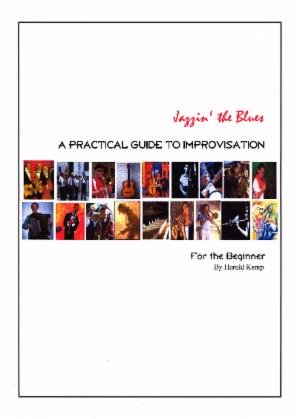Jazzin' the Blues: for the beginner
INTRODUCTION
Hi,
This is a book is about improvisation.
You mean making stuff up as you go along?
Well...
In this book we'll be looking at various 2, 3 or 4 note phrases (cells) that can be joined to other cells to form longer musical sentences. This is what improvisation is all about. If you play by ear, the cells will already be in your head. All you have to do is organise them. If they're in a book, all we have to do is move them into our memory banks first and then combine them into musical ideas.
There is a method and no mystery.
Once you've got the hang of scales, making up your own cells (in Part 1) is an interesting way of spending a rainy afternoon. Before you know it you'll have pages of short phrases ready to combine into jaw dropping runs. Your friends will be amazed.
Back to reality.

I've opted for the blues as the tune to try out our improvisations.
Why the blues?
Everyone has a fairly good idea what the blues is all about. There isn't anyone who hasn't either played them or won't get round to playing them. The other reason is that the blues chord progression is as difficult and demanding or as simple and disarming as you want to make it.
We'll keep it simple.
We're not taking any particular blues tune; we'll make up our own. What we are taking though, is the blues chords.
My first notation of the blues chord was this very popular progression:
G7 G7 G7 G7
C7 C7 G7 E7
Am7 D7 G D7
The problem with the chords above was that there was only one major chord in the 12 bars. What would be the point of looking at major cells if, when we played through the blues, all we had was one major chord to play on. We needed more space on which to work out our major cells. The answer was to start off with a 12 bar blues progression using major chords instead of dominant seven chords in the first two lines:
G G G G
C C G E7
Am7 D7 G D7
Ok, so far. Our first set of blues chords, however, would do us nicely for the dominant seven work outs as it's bulging with dom7's. And we could stretch out our major cell combinations on the second set of chords (above).
What about the minor chord ?
I knew you would ask.
We could practice our minor cells with a minor blues. How's that !
Gm Gm Gm Gm
Cm Cm Gm Gm
Dm Cm Gm D7
The book is divided into three sections:
PART 1 lists the basic cells that will enable you get going using chords and scales with the
major, minor and dominant blues progressions.
PART 2 contains chords and scales for C7, D7 and E7.
PART 3 has the explanations for words highlighted in red in the book
Please feel welcome to email me if anything needs clarification. I'd also like to know how you get on with the book, what's really useful or would make a useful addition, what needs changing or leaving out because it causes confusion.
All the best with the book,
HK 2008
> CONTENTS